Our official English website, www.x-mol.net, welcomes your feedback! (Note: you will need to create a separate account there.)
Synthesis of iron nanoparticles-based hydrochar catalyst for ex-situ catalytic microwave-assisted pyrolysis of lignocellulosic biomass to renewable phenols
Fuel ( IF 7.4 ) Pub Date : 2020-11-01 , DOI: 10.1016/j.fuel.2020.118532 Leilei Dai , Zihong Zeng , Qi Yang , Sha Yang , Yunpu Wang , Yuhuan Liu , Roger Ruan , Chao He , Zhenting Yu , Lin Jiang
Fuel ( IF 7.4 ) Pub Date : 2020-11-01 , DOI: 10.1016/j.fuel.2020.118532 Leilei Dai , Zihong Zeng , Qi Yang , Sha Yang , Yunpu Wang , Yuhuan Liu , Roger Ruan , Chao He , Zhenting Yu , Lin Jiang

|
Abstract Selective production of phenols via ex-situ catalytic pyrolysis of lignocellulosic biomass is a promising route in biomass conversion. Therefore, developing a low-cost and effective catalyst for this process has emerged as an important topic. Here, the iron nanoparticles-based carbonaceous catalysts were prepared via combining hydrothermal carbonization and pyrolysis approach and first used in the catalytic microwave-assisted pyrolysis of torrefied corn cob for phenols production. The effects of catalyst types, catalytic temperature, and catalyst to feedstock ratio on the production of phenolic compounds were studied. The total selectivity of phenols can reach 91.07 area% with the total yield of 18706.6 µg/ml bio-oil using the FeHC@ hydrochar catalyst (prepared by hydrothermal carbonization in the Fe(NO3)3 solution and pyrolysis) at the catalytic temperature of 450 °C and catalyst to feedstock ratio of 5:10. After using seven times, partial loss of catalytic activity of FeHC@hydrochar was found. This study also presented unique insights into the deactivation of carbonaceous catalysts, showing that sintering, oxidation of α-Fe and Fe3C phases, active site coverage, and pore blockage were the causes of the reduction of catalytic performance. Regeneration experiments showed that it is impracticable to calcine deactivated catalyst at an inert atmosphere and more advanced techniques needed to be developed to solve this problem. Overall, this study can provide a reference for realistic scale-up production of renewable phenols.
中文翻译:

基于铁纳米颗粒的水碳催化剂的合成用于木质纤维素生物质的异位催化微波辅助热解为可再生酚类
摘要 通过木质纤维素生物质的异位催化热解选择性生产苯酚是生物质转化的一条有前途的途径。因此,为该过程开发一种低成本且有效的催化剂已成为一个重要的课题。在这里,铁纳米颗粒基碳质催化剂是通过结合水热碳化和热解方法制备的,并首次用于催化微波辅助热解烘焙玉米芯以生产苯酚。研究了催化剂类型、催化温度和催化剂与原料比对酚类化合物生产的影响。酚类总选择性可达91.07面积%,总收率为18706。6 µg/ml 生物油,使用 FeHC@hydrochar 催化剂(通过在 Fe(NO3)3 溶液中水热碳化和热解制备),催化温度为 450 °C,催化剂与原料的比例为 5:10。使用七次后,发现 FeHC@hydrochar 的催化活性部分丧失。该研究还对碳质催化剂的失活提出了独特的见解,表明烧结、α-Fe 和 Fe3C 相的氧化、活性位点覆盖和孔隙堵塞是催化性能降低的原因。再生实验表明,在惰性气氛中煅烧失活的催化剂是不切实际的,需要开发更先进的技术来解决这个问题。总体而言,该研究可为可再生苯酚的现实规模化生产提供参考。
更新日期:2020-11-01
中文翻译:

基于铁纳米颗粒的水碳催化剂的合成用于木质纤维素生物质的异位催化微波辅助热解为可再生酚类
摘要 通过木质纤维素生物质的异位催化热解选择性生产苯酚是生物质转化的一条有前途的途径。因此,为该过程开发一种低成本且有效的催化剂已成为一个重要的课题。在这里,铁纳米颗粒基碳质催化剂是通过结合水热碳化和热解方法制备的,并首次用于催化微波辅助热解烘焙玉米芯以生产苯酚。研究了催化剂类型、催化温度和催化剂与原料比对酚类化合物生产的影响。酚类总选择性可达91.07面积%,总收率为18706。6 µg/ml 生物油,使用 FeHC@hydrochar 催化剂(通过在 Fe(NO3)3 溶液中水热碳化和热解制备),催化温度为 450 °C,催化剂与原料的比例为 5:10。使用七次后,发现 FeHC@hydrochar 的催化活性部分丧失。该研究还对碳质催化剂的失活提出了独特的见解,表明烧结、α-Fe 和 Fe3C 相的氧化、活性位点覆盖和孔隙堵塞是催化性能降低的原因。再生实验表明,在惰性气氛中煅烧失活的催化剂是不切实际的,需要开发更先进的技术来解决这个问题。总体而言,该研究可为可再生苯酚的现实规模化生产提供参考。



























 京公网安备 11010802027423号
京公网安备 11010802027423号